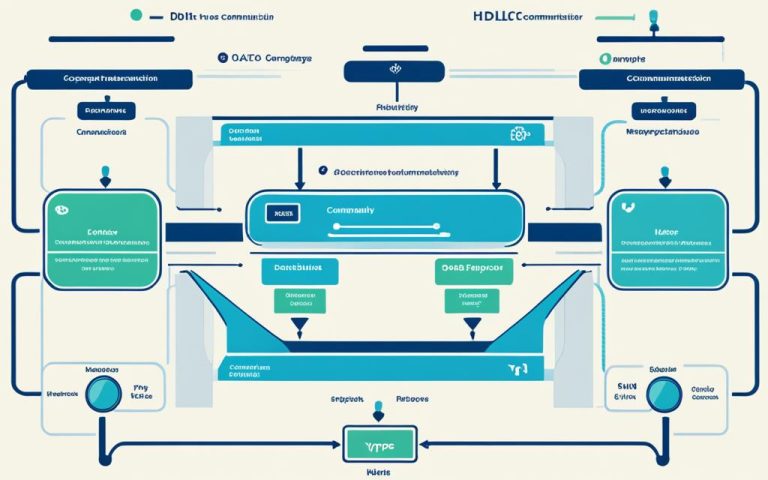When a company faces a network compromise, the effects can be severe. Financial losses, legal issues, and harm to the company’s reputation are just a few risks. To handle this crisis, having strong data breach response plans is key. These plans help lessen the damage and get operations back on track. This article will explore expert advice and key steps for dealing with and investigating network breaches.
Experts say the first step after a network hack is to call in an Incident Response Team. Trained IT staff should then cut off the affected systems from the network. This step1 is crucial to stop the breach from spreading to other devices.
It’s important to document how you isolate systems for legal and compliance reasons. Include exact times and steps taken1 in these records. This makes things clear for legal cases and investigations later on.
Experts suggest using two firewall rules to manage the situation. Standard rules and “lockdown mode” rules help control the breach’s spread1. This strategy limits the damage from the compromised systems.
After isolating the threat, a deep clean of all devices is needed. Using strong antivirus and anti-malware tools is key1 in removing the threat.
Experts recommend changing passwords, applying security updates, doing forensic analysis, and strengthening security to fix found weaknesses1. Taking these steps helps prevent future breaches and improves security.
During the clean-up, figuring out how hackers got in is crucial. This helps in making changes to stop similar breaches in the future1.
Even after cleaning up, keeping a close watch on systems is important. Automating the detection and fixing of threats helps stop reinfection and protects against new attacks1.
Backups are vital for recovery, but they can also be affected by a breach. It’s important to check the backups’ integrity before using them1.
Removing malware, unauthorized users, and compromised accounts completely is a key step. This ensures a safe and secure environment1.
Key Takeaways:
- Activating the Incident Response Team and isolating affected systems are vital initial steps in responding to a network compromise.
- Documenting the entire isolation process, including timestamps and actions taken, aids compliance and legal investigations.
- Utilizing two sets of firewall rules, standard rules, and “lockdown mode,” is an effective approach for controlling the impact of compromised systems during investigation.
- Eradicating the threat involves thorough scanning and cleaning of devices, servers, and cloud instances.
- Changing compromised passwords, conducting forensic analysis, and reinforcing security measures are recommended steps to address vulnerabilities.
- Root cause analysis is crucial to understanding how hackers gained access and implementing preventive measures.
- Continuous monitoring and automated remediation prevent malicious presence post-threat eradication.
- Verify the integrity of backups and eliminate malware, unauthorized users, and compromised accounts from affected systems.
Understanding the Consequences of a Data Breach
A data breach can cause big problems for companies. These problems include financial losses, legal issues, downtime, and damage to reputation. It’s important to know how these breaches affect companies to make good plans to deal with them.
Financial Losses
Financial losses are a big deal from data breaches. On average, a breach costs companies $4.24 million2. This money goes towards paying off affected customers, fixing the issue, and more.
Legal Ramifications
Data breaches can lead to big legal problems. Laws from the federal and state levels might apply3. Companies could face fines up to 4% of their yearly earnings or 20 million Euros under the GDPR. The Irish Data Protection Commission once fined Meta $1.2 billion. Class-action lawsuits have also hit companies like Equifax and Uber hard2.
Operational Downtime
Data breaches can make companies unable to work. When data is stolen or locked, it stops business and makes systems down. Companies should tell the police right away if they find a breach3. It takes about 277 days to figure out and stop a breach, which hurts work and keeps things from running smoothly.
Reputational Damage
Reputational damage is a big issue from data breaches. Companies can lose customer trust. Up to a third of customers might leave, and many will tell others about the breach2. This can lead to fewer customers, missed business chances, and a bad brand image for a long time.
In summary, a data breach can cause big problems for companies. These problems include money losses, legal issues, downtime, and damage to reputation. It’s key for companies to focus on keeping data safe and having good plans for when things go wrong.
| Consequences of a Data Breach | Statistical Data |
|---|---|
| Financial Losses | Financial loss to organizations from a data breach is $4.24 million |
| Legal Ramifications | GDPR fines can be up to 4% of the company’s global revenue or 20 million Euros |
| Operational Downtime | Average time to identify and contain a breach is 277 days |
| Reputational Damage | Up to a third of customers stop doing business with breached organizations |
The Importance of Data Breach Incident Response and Investigation
Data breach incident response and investigation are key to handling a data breach and protecting companies. They help reduce the effects of breaches, shorten recovery time, and keep costs down. By having strong incident response plans and detailed investigations, companies can lessen the damage and keep their reputation safe.
Minimizing Harm and Reducing Recovery Time
Data breaches can severely hurt organizations, both in their wallets and their image. In 2015, the cost per record in a breach went up to $2174. For a breach of 20,000 records, the cost could hit $4.3 million4. This shows how crucial quick and effective response is to cut financial losses and protect the company’s image.
Incident response helps spot, stop, and fix cyberattacks and their effects5. Acting fast and using containment steps can reduce the breach’s impact and stop more damage. With a solid incident response plan, companies can quickly deal with issues, shorten recovery time, and keep operations going.
Effective Investigation for Comprehensive Understanding
Investigating a data breach is a key part of responding to an incident. It means collecting evidence, looking into breaches, and figuring out the full damage. Through this, companies learn about the breach, the weaknesses used, and how it affected the data6.
Digital forensics teams bring valuable experience and analysis from working with different companies and breaches4. They offer deeper analysis and advice for improving security in the future, more than in-house teams with less outside experience4.
How to Handle a Data Breach: Cyber Incident Response Guides
Handling a data breach requires a proactive approach to lessen damage and speed up recovery. Luckily, there are guides that offer detailed advice for organizations to tackle security incidents well. These guides help in reducing the effects of a breach.
The Computer Security Incident Handling Guide from NIST7 and the Incident Handler’s Handbook from the SANS Institute7 are great resources. They give step-by-step advice for teams to follow during a breach.
Using these guides, organizations can make their response smoother, lessen the breach’s impact, and act proactively. The steps include preparation, detection, containment, eradication, recovery, and post-incident activities7. These steps help organizations manage breaches thoroughly.
It’s key to remember that incident response plans should change with new threats and strategies. Updating these plans regularly with lessons from past incidents is vital7. This keeps organizations ready for new cyber risks and makes their plans effective.
Businesses should also think about getting cyber insurance from providers like AmTrustCyber8. These services offer 24/7 help against cyber threats. Cyber insurance can offer extra protection and support during a breach.
In summary, following cyber incident response guides and keeping up with prevention strategies helps organizations deal with data breaches well. A proactive approach to handling incidents is crucial in today’s fast-changing cybersecurity world.
Building a Data Breach Response Plan: Key Elements and Importance
A data breach response plan is key to handling a security issue well. It outlines steps to follow during a security incident. With a good plan, businesses can lessen financial losses, deal with legal issues, and keep their reputation safe after a cyber attack.
Key elements of a data breach response plan include:
- Clear definition of a data breach: The plan should clearly define what a data breach is. This ensures everyone knows what to do9.
- Incident response team: Assign a team to handle the data breach response. Make sure everyone knows their role for smooth coordination9.
- Step-by-step process: Outline the steps from spotting a breach to recovery. This helps avoid confusion and keeps the response structured9.
- Technological means: Use strong tools and tech for detecting and stopping a breach quickly.
- Emergency contacts: List contacts, inside and outside the company, to call during a breach9.
- Communication strategy: Have a plan for telling people about the breach quickly and accurately. This helps keep trust and avoids bad publicity.
- Instructions for regulatory compliance: The plan should guide on following data breach laws to avoid legal trouble9.
- Incident response scenarios: Prepare for different types of cyber attacks, like data breaches and ransomware attacks9.
- Team assembly: Know who puts together the incident response team and their roles and decision-making power.
- Vulnerability identification: Find and fix weaknesses in systems to prevent security risks.
- External cybersecurity expert engagement: Sometimes, bring in outside cybersecurity experts for complex incidents.
- Data backup resources: Have strong data backup and recovery plans to keep business running and data safe.
Creating a data breach response plan is ongoing. It needs regular updates to keep up with new threats. Testing the plan helps check its strength and spot areas to improve9.
Good communication is key after a breach. It’s important to tell those affected and follow the law. The crisis PR team helps manage messages to everyone9.
Importance of a Data Breach Response Plan
Every organization needs a data breach response plan. It’s a way to act fast and reduce losses from a breach. Cybercriminals cause huge financial losses to U.S. businesses every year10.
A breach can also put employee info at risk, leading to identity theft. Millions of identities are stolen yearly, showing the need for a strong plan10.
Having a good plan helps follow laws too. Cyber laws are getting stricter, and companies must show they can handle breaches well. Practicing the plan regularly keeps them ready and compliant10.
Simulating data breach scenarios is a good idea. It helps find and fix weak spots in the response. Doing these simulations yearly gives insights into how prepared the organization is10.
After a breach, HR is key in the response. They notify employees, answer questions, help with identity theft, and work to prevent future breaches10.
In summary, a well-made data breach response plan helps organizations act fast and lessen the damage from a cyber attack. It protects their reputation and keeps their stakeholders safe10.
Steps of Data Breach Response and Investigation Process
When a data breach happens, it’s crucial to act fast. This helps protect sensitive info and rebuild trust. The steps for handling a data breach are key to managing its effects well.
Step 1: Preparation
Before a breach, prepare by making a detailed plan for how to respond. Include who does what, how to communicate, and emergency contacts. This plan should also outline the steps to take during a breach.
Reference: 11
Step 4: Evidence Gathering
Collecting evidence is vital for a deep investigation and legal steps. Keep logs, take screenshots, and document the incident to learn what happened and who did it.
Step 5: Breach Analysis
Looking closely at the breach helps understand its scope and how attackers worked. This shows the damage, their methods, and weak spots to fix.
Reference: 6 Steps Emergency Plan for Data Breach Response11
Step 6: Containment
Stop the breach from spreading by taking steps to block further unauthorized access. Isolate affected systems, fix vulnerabilities, and add stronger security.
Step 7: Notification of Affected Parties
Telling those affected is key to being open and rebuilding trust. Make sure to communicate clearly and offer advice on how they can protect themselves.
Reference: How to Create a Data Breach12
Step 8: Post-Incident Activities
After the breach is under control and people are told, review what happened and how you responded. Look for ways to get better and make changes to avoid future breaches.
Reference: How to Create a Data Breach Policy12
By following these steps, companies can handle data breaches well. This helps reduce financial losses, keeps their reputation safe, and speeds up recovery.
| Step | Description |
|---|---|
| 1 | Preparation: Develop a comprehensive data breach response plan. |
| 2 | Detection: Swiftly identify unauthorized access and unusual activities. |
| 3 | Urgent Incident Response Actions: Take immediate steps to mitigate further damage. |
| 4 | Evidence Gathering: Collect evidence for investigation and potential legal proceedings. |
| 5 | Breach Analysis: Thoroughly examine the breach to understand attackers and vulnerabilities. |
| 6 | Containment: Implement measures to prevent further unauthorized access. |
| 7 | Notification of Affected Parties: Communicate with impacted individuals and provide guidance. |
| 8 | Post-Incident Activities: Review the incident, improve response plans, and prevent future breaches. |
Preparing for a Data Breach: Risk Assessment and Incident Response Team
Before a data breach happens, it’s key for organizations to get ready and lessen risks. A big step is doing a detailed risk assessment. This helps spot weak spots in the systems and processes that could lead to a breach. Knowing the risks lets organizations put in place strong security steps to lower the chance of a breach. The aim is to build a strong defense against cyber threats and keep data safe.
Having an incident response team ready is also crucial. This team has people with the right skills for dealing with cyber attacks. They work together to quickly handle a breach, lessen its effects, and protect the organization’s good name. They tackle the technical, legal, and communication parts of the response.
It’s smart for organizations to use cybersecurity software to fight data breaches. This software uses smart algorithms and threat info to spot and stop threats early. It watches network activities, looks for patterns, and flags anything odd. This software is a key defense against unauthorized access and data breaches.
Reference:
- Having a plan for security incidents is vital for any company. Without one, an organization might face higher costs and more damage13.
- Reacting fast to incidents cuts losses, gets things back to normal, and fixes weak spots, preventing big data breaches13.
- Not dealing with an incident fast can lead to losing data, system crashes, and high costs for fixing things, plus legal and financial trouble13.
- Phishing and social engineering tricks people into sharing private info13.
- DDoS attacks flood networks to make them unavailable to users13.
- Software supply chain attacks use partners or suppliers to get into systems, avoiding usual security checks13.
- Ransomware attacks encrypt files and demand money to unlock them, causing business disruption and financial loss13.
- Insider threats come from within and are hard to spot, leading to theft of intellectual property, financial fraud, and damage to reputation1314.
- The Securities and Exchange Commission makes companies tell about cyber attacks within four days if they’re big enough13.
By doing a deep risk assessment, setting up an incident response team, and using strong cybersecurity software, organizations can be ready to protect their data. These steps are key to lessening the effects of a breach and keeping the organization and its people safe.
Detecting a Data Breach and Urgent Incident Response Actions
Finding out about a data breach is the first step in dealing with a network issue. It’s important for companies to watch their systems closely for any signs of unauthorized access. Tools like intrusion detection systems and log analysis can spot signs of a breach.
When a breach is found, acting fast is key. Quick actions can lessen the harm from a data breach. Protecting the company and its people is a top goal.
Getting a team ready to handle the breach is vital. This team should include cybersecurity experts, legal advice, and other important people. They will work together to secure systems, look into the breach, and fix problems.
Experts in data forensics are crucial to understand the breach’s details. They help find out how the breach happened and who did it. This info is key for handling the incident and making the company stronger against future threats.
Legal advice is also key to follow the law and keep evidence for legal steps. Lawyers help with how to tell people about the breach, keep data private, and handle legal issues.
Stopping more data loss is a must to control the breach. Quickly finding and stopping hacked accounts, securing access, and fixing weaknesses helps stop more unauthorized access. This limits how much data is at risk.
Securing Operations
Securing operations is very important during a data breach. It means finding where the breach started, cutting off affected systems, and using network walls to stop the breach from spreading.
Checking user access rights and using the least privilege rule is also key. This makes sure only the right people can see important systems and data. Watching access logs helps spot strange actions and insider threats.
Removing Improperly Posted Information from the Web
Sometimes, hackers share stolen data online or on the dark web. Quick action is needed to take down this information. This stops more damage and protects those affected.
Containment, Eradication, and Recovery Measures
When a data breach is found, it’s key to act fast. This means taking steps to stop more damage, fix the issue, and get back to normal.
First, we focus on containing the breach. This means stopping the attack from spreading. We do this by isolating infected computers and changing passwords. It’s also vital to update systems and check backups for long-term safety15.
Next, we work on eradicating the malware. This means getting rid of the harmful code from our systems. We do this by making our systems stronger and updating them to close security gaps15.
After the breach is under control and our systems are safe, we start the recovery process. This means fixing the damaged systems and testing them to make sure they’re okay. We also keep an eye out for any more problems and use tools to boost security15.
During recovery, we also look into what happened and how we can do better. By learning from the breach, we can improve our security and get ready for the future15.
Testing and validating our systems is key during these steps. It makes sure everything is secure and working right. We also need to keep up with regular checks to meet industry standards15.
In this important part of handling a breach, acting quickly is crucial. By taking the right steps, we can lessen the harm, get back to normal, and improve our security for the long run15.
Notifying Affected Parties and Conducting Post-Incident Activities
Telling those affected by a data breach is key. It helps them protect themselves and take the right steps. This is crucial for both individuals and businesses.
Being open builds trust. Quick updates can show people how big the breach is and the risks they might face.
Companies must follow laws about telling people about data breaches. These laws change depending on where you are. For instance, in Alabama, you have to tell people within 45 days after learning about the breach16. Alaska made its data breach law in 200816.
In Arizona, you must tell those affected within 45 days after finding out about the breach16. California made its law in 200216. Colorado says you have to notify people within 30 days if there was unauthorized data taking16. Connecticut made its law in 200516.
Telling the police about a cyberattack is also important. It helps find the bad guys and make sure they face the law17.
After fixing the breach and finishing the investigation, there’s more to do. Doing a forensic analysis helps find security weak spots. It also gives clues on how to make things stronger17.
Learning from the breach is key. Use what you learn to improve, like updating software, fixing weak spots, and using better security checks17.
Good communication is key before and after a cyberattack. It helps keep trust. Tell those affected about the attack, what you did, and what they should do to stay safe17.
Businesses also need to keep improving after a breach. This means updating and testing how you handle such incidents. Regular checks and updates help you be ready for the next threat. This way, you can respond quickly and effectively17.
Incident Response Methodology for Effective Security Incident Handling
Handling security incidents well means having a clear incident response methodology. This approach helps deal with security breaches in a structured way. It ensures threats are quickly found and stopped. The NIST Computer Security Incident Handling Guide and the SANS Incident Handler’s Handbook are key frameworks for this.
Following a incident response methodology means going through certain steps. These steps help manage incidents well. They include preparation, detection and analysis, containment, eradication, recovery, and post-incident audits. Each step is vital for lessening the effects of security incidents and responding quickly and well.
Preparation is key in incident response. It means being ready for security breaches18. This includes making an incident response plan, setting up a team, and using technical controls to boost security.
Identifying incidents is the first step. IT staff must quickly spot incidents to cut costs and damage18. This needs strong detection and monitoring to catch security breaches early.
After spotting an incident, the goal is containment18. This step aims to stop further damage and lessen the incident’s impact. It means isolating affected systems, limiting access, and keeping evidence safe for legal use.
Then, the eradication phase starts18. This phase is about getting rid of threats and fixing systems. Cybersecurity experts are often needed to investigate and make sure all traces of the threat are gone.
After fixing systems, the recovery phase comes18. This phase is about testing and checking systems before they go back online. It also means reviewing and updating incident response plans based on what was learned from the incident.
Post-incident audits are key for getting better at incident response18. They look at how the incident was handled, find areas for improvement, and make changes to get better at responding to incidents.
Using an incident response methodology with these steps helps organizations handle security incidents well. It ensures incidents are caught and dealt with quickly, reducing damage and costs.
Organizations should keep their incident response methods up to date with new cyber threats19. Staying proactive lets them adjust their plans and procedures to tackle new risks. Also, good communication and using tools like SOAR software can make incident response more efficient and effective20.
In conclusion, having an incident response methodology is crucial for dealing with security incidents. It outlines steps like preparation, detection, containment, eradication, recovery, and audits for a structured approach. By following this, organizations can lessen the impact of security breaches and improve their incident response skills.
Conclusion
Handling network compromises and data breaches needs a detailed and strategic plan. It’s key for companies to know how a data breach can affect them. They should focus on responding to these incidents quickly and effectively.
Having a plan for data breaches is vital. This plan should include steps to manage security issues well. By doing this, companies can deal with security problems more efficiently.
Security policies are crucial for keeping data safe and ready for emergencies. Companies must tailor their security to fit their specific needs. This means keeping personal info safe and making sure account records are secure21.
Quick action is key in stopping attacks from spreading further. Being open about a breach helps keep trust. Good communication within the company helps in responding to the breach well.
It’s important to assess the damage fast and take steps to fix it. Regular checks for security weaknesses are also key. This helps stop future breaches and keeps systems safe22.
Many companies think they’re already under attack, and investing in the right tech is important. It’s hard to keep control and know about all the weaknesses. But, working on security intelligence and sharing info with others is crucial for ongoing protection23.
FAQ
What are the consequences of a data breach?
A data breach can lead to financial losses, legal issues, downtime, and damage to a company’s reputation.
Why is data breach incident response and investigation important?
Handling a data breach well helps lessen harm and cut down on recovery costs and time.
Are there any cyber incident response guides available?
Yes, guides like the Computer Security Incident Handling Guide from NIST and the Incident Handler’s Handbook from SANS are out there. The Microsoft Incident Response Guide is another useful resource.
What should be included in a data breach response plan?
A good plan should clearly define what a data breach is. It should have a team ready to respond, with clear roles. It should outline steps to follow during a breach, use tech for detection and prevention, and have contact info for various groups. It should also cover how to talk to regulators, those affected, customers, and the media.
What are the steps involved in the data breach response and investigation process?
The process includes getting ready for a breach, spotting it, and taking quick action. Then, gather evidence, analyze the breach, and take steps to stop and fix it. Notify those affected and do activities after the incident.
How can organizations prepare for a data breach?
Preparation involves assessing risks, setting up an incident team, and using cybersecurity tools for detection and prevention.
What actions should be taken when detecting a data breach?
When a breach is found, act fast. Secure operations, gather a team, get legal advice, stop more data loss, and remove sensitive info from the internet.
What measures should be implemented for containment, eradication, and recovery?
For containment, quarantine infected computers and apply security updates. Reset passwords, back up systems, and test everything. Make sure to recertify any compromised parts and have a long-term plan for security.
How should affected parties be notified after a data breach?
Notify people as the law requires, including law enforcement and those directly affected. Also, review what happened, improve security, and update your response plan.
What is an incident response methodology?
An incident response methodology is a step-by-step way to handle security issues. It includes preparing, detecting and analyzing, containing, eradicating, recovering, and auditing after the incident. Guides like the NIST Computer Security Incident Handling Guide and the SANS Incident Handler’s Handbook help outline these steps.
Source Links
- https://www.linkedin.com/advice/3/your-network-has-been-hacked-whats-first-step-uzufe – Your network has been hacked. What’s the first step to take in order to secure it?
- https://www.nedigital.com/en/blog/data-breach-consequences – What are the Consequences of a Data Breach?.
- https://www.ftc.gov/business-guidance/resources/data-breach-response-guide-business – Data Breach Response: A Guide for Business
- https://www.travelers.com/resources/business-topics/cyber-security/digital-forensics-detectives-investigate-data-breach – How Digital Forensics Detectives Investigate a Data Breach | Travelers Insurance
- https://www.techtarget.com/searchsecurity/definition/incident-response – What is Incident Response? Definition and Complete Guide | TechTarget
- https://www.linkedin.com/pulse/incident-response-building-resilient-security-infrastructure – The Importance of Incident Response
- https://www.exabeam.com/blog/incident-response/6-incident-response-steps-what-to-do-when-under-attack/ – 6 Incident Response Steps: What to Do When Under Attack
- https://amtrustfinancial.com/blog/insurance-products/what-to-do-after-a-data-breach-or-cyber-attack – What to Do After a Data Breach | AmTrust Financial
- https://www.embroker.com/blog/cyber-incident-response-plan/ – How to Design a Cyber Incident Response Plan – Embroker
- https://www.allstateidentityprotection.com/business/content-hub/how-to-create-an-employee-data-breach-response-plan-for-hr – How to create an employee data breach response plan for HR | Allstate Identity Protection
- https://blog.gitguardian.com/data-breach-response-a-6-steps-emergency-plan/ – Data Breach: a 5 Steps Response Plan
- https://amtrustfinancial.com/blog/small-business/how-to-create-a-data-breach-policy – How to Create Company Data Breach Response Plan | AmTrust Financial
- https://www.exabeam.com/blog/incident-response/incident-response-6-steps-technologies-and-tips/ – Incident Response: 6 Steps and the Teams and Tools that Make Them Happen
- https://www.dataguard.co.uk/blog/data-breach-management/ – Data breach management – what to do when your company is compromised
- https://www.securitymetrics.com/blog/6-phases-incident-response-plan – 6 Phases in the Incident Response Plan
- https://www.itgovernanceusa.com/data-breach-notification-laws – Data Breach Notification Laws by State
- https://www.botkeeper.com/blog/youve-been-hacked-now-what – You’ve been hacked! Now what?
- https://www.digitalguardian.com/blog/what-incident-response – What is Incident Response? (Definition & 6 Steps to Take)
- https://www.privatebank.bankofamerica.com/articles/cyber-security-incident-response-plan.html – Creating a Cyber Security Incident Response Plan
- https://otrs.com/use-cases/corporate-security/security-incident-management/ – Security Incident Management
- https://nap.nationalacademies.org/read/1581/chapter/4 – Concepts of Information Security | Computers at Risk: Safe Computing in the Information Age
- https://stwbrasil.com/en/blog/what-to-do-if-your-companys-data-is-compromised/ – What to Do If Your Company’s Data Is Compromised
- https://www.linkedin.com/pulse/my-industry-were-all-compromised-mário-platt – ‘In my industry, we’re all compromised’



















